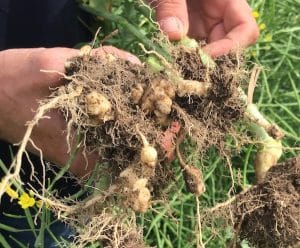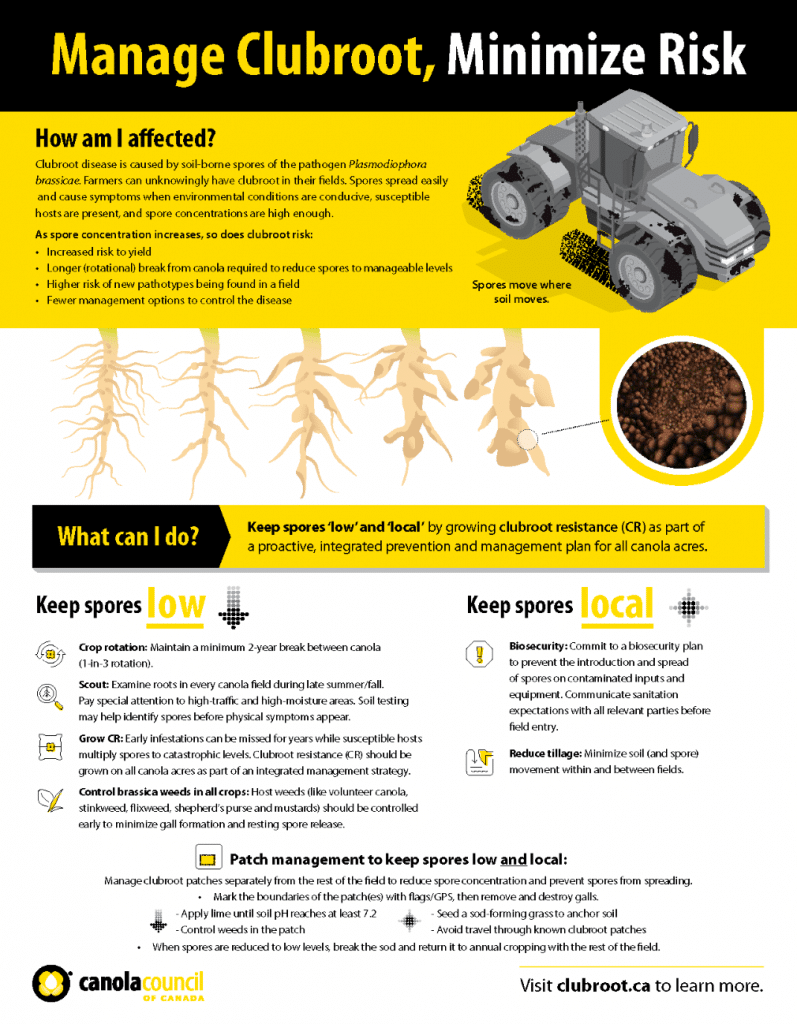The three best tools to prevent and manage clubroot are scouting to identify the presence and severity of the disease, a minimum two-year break between host crops on a field, and effective genetic resistance. This article describes these three steps and a few other extra steps to enhance prevention and management.

1. Scout
The telltale symptom of clubroot are club-shaped growths – or “galls” – on roots. Galls produce the spores that perpetuate the disease. Severely infected roots can’t transport adequate water and nutrients to above-ground plant tissues, which can cause wilting, reduced seed production, stunting and possibly premature death of the plant. In many cases, a few galls may not cause severe yield loss in a given year but do set up for potential severe yield loss in future years. Presence of galls indicates the need for further management.
To scout, pull up plants to check roots for galls. Check random healthy looking plants. Also target unhealthy plants to confirm the cause. Clubroot is one of many potential causes, and management depends on accurate diagnosis.
New infestations tend to begin near the field access because contaminated equipment is the predominant spread mechanism. Other high risk areas are low spots which often have excess moisture, water runs and high-traffic areas. Scout these areas.
The Canola Encyclopedia has more on scouting.
2. Have a minimum two years between canola crops
Research shows that a two-year break from clubroot hosts is the minimum. Fields or patches with high spore concentrations will benefit from a longer break, as the remaining 10 per cent of spores will still be high enough to cause disease.
Evidence for this statement comes from rotation studies in Quebec and Alberta. Thomas Ernst, who did the Alberta study, observed an eight- to 20-fold drop in resting spore concentrations with a two-year break after growing clubroot-resistant canola. With a one-year break, Ernst found that resting spore numbers never drop enough to provide any reduction in risk.
Gary Peng, research scientist with Agriculture and Agri-Food Canada (AAFC) in Saskatoon, led a Quebec study. In fields with heavy clubroot infestation, Peng showed that a two-year break between canola crops can reduce the pathogen inoculum in the soil by up to 90 per cent relative to a one-year break. Yield benefits from this two-year break showed in resistant cultivars as well as susceptible. More on rotations for disease management.
3. Choose cultivars with genetic resistance
A recent study (Gossen et al) confirmed that growers should always select resistant cultivars for use in infested fields. Resistance and crop rotation in combination are the two most effective management steps, the study concluded, because rotation alone is not enough. High numbers of clubroot spores are almost always still present after five years of non-host crops.
Stephen Strelkov led a study, which concluded in 2024, on second generation resistance. It showed how second generation resistance is not always an improvement over first generation resistance: Some second-generation cultivars evaluated in this study exhibited significantly improved resistance to pathogen isolates that were virulent on first-generation resistance. Other second-generation cultivars had resistance profiles that were either similar or notably inferior to first-generation resistance. Find a brief summary of this work here. The Canola Encyclopedia has a list of current canola cultivars and their traits, including first or second generation clubroot resistance.
Other management steps
Growers have other management steps to prevent the introduction of spores to a field and manage clubroot patches before they spread to the whole field or farm. The Canola Council of Canada grower survey of 2024 asked what biosecurity measures growers use to prevent soil-borne pathogens, insects and weed seeds from entering the farm, the top answer was “none of the above” at 51 per cent. The most common practice is to clean any purchased equipment before taking it to the field, but only 30 per cent of respondents say they do this. Only 19 per cent remove soil from equipment before leaving a field. All other practices had lower interest and uptake.
Sanitize equipment
Farm machinery can be a highly efficient way to spread hundreds of pounds of infested soil a long distance and very quickly. And yet it can take only a few grams of infested soil to introduce a problem pest like clubroot. Wet soil conditions increase the amount of soil that clings to tires and openers. Cleaning tips
Minimize soil movement
While long-term perennial grass cover crop on clubroot patches did not reduce spores, according to the Gossen study, the practice does hold soil in place. This minimizes wind and water erosion of infested soil. It also reduces the risk of contaminating farm machinery and other vehicles driven across the infested patch. Other ways to minimize soil movement:
- Minimize tillage in all fields.
- Avoid travelling through clubroot-affected area(s), especially in wet conditions.
- Knock soil off equipment before leaving fields.
Plant grass cover crops
The same Gossen study that recommended resistant cultivars and crop rotation in combination also examined the effect of liming and grass cover crops on survival of resting spores of P. brassicae. It concluded that short-term dense planting of grass and cereal crops produced a small reduction in resting spore concentration in infested soil. However, this effect was not detectable at field sites, regardless of soil type or pH. If growers use grass cover crops to contain a clubroot patch, use soil tests to quantify a low level of clubroot spores before returning the area to annual cropping.
Apply lime to increase soil pH
Gossen also concluded that application of lime did not reduce spore numbers relative to the untreated control. The target pH for liming treatments was 7.5, but it was difficult to maintain that pH at sites with highly acidic soil.
Other greenhouse trials in Alberta showed that clubroot galls will grow prolifically in solutions with pH of 6.5 but not at all in solutions with pH of 7.3. The challenge is that this target pH of 7.3 is far beyond what is economical or required from a general nutrient availability, aluminum toxicity and yield benefit. The lime required to reach 7.3 and keep it there can be prohibitively expensive. More on lime.
Control host weeds
Volunteer canola, stinkweed, flixweed, shepherd’s purse, and mustards are all susceptible to clubroot. To get full value from crop rotation to manage clubroot, remove these weeds from the break crops. Early weed control is key to minimizing spore reproduction and clubroot risk.
More…
Canola Encyclopedia chapter on clubroot

